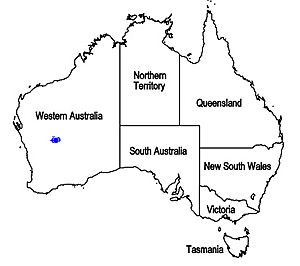Pityrodia canaliculata facts for kids
Quick facts for kids Pityrodia canaliculata |
|
|---|---|
| Conservation status | |
| Scientific classification | |
| Genus: |
Pityrodia
|
| Species: |
canaliculata
|
 |
|
| Occurrence data from the Atlas of Living Australia | |
The Pityrodia canaliculata is a special flowering plant that belongs to the mint family (called Lamiaceae). It only grows in a small part of Western Australia. This plant is a bushy shrub with many branches. Almost all of its parts, except the petals, are covered in tiny, round scales. Its flowers are shaped like tubes and are white with reddish spots inside.
About the Pityrodia Plant
The Pityrodia canaliculata is a shrub that can grow between 1–2.5 m (3–8 ft) tall. Its branches and leaves are covered with many tiny, round scales. The leaves are dark green and grow in pairs, one across from the other. They are also covered with the same scales as the branches.
The leaves are about 1.5–4.5 cm (0.6–2 in) long and 2–4 mm (0.08–0.2 in) wide. They are long and narrow, with a small groove on the top and a ridge on the bottom.
Flowers and Fruit
The flowers grow alone or in small groups of up to three. They appear on short, scaly stalks, about 1.5–3 mm (0.06–0.1 in) long, where the leaves meet the stem. The flower has five sepals, which are like small leaves that protect the bud. These sepals join together to form a bell-shaped tube, about 3–4.5 mm (0.1–0.2 in) long. The outside of this tube is scaly, but the inside is smooth.
The five petals are joined to form a white tube, about 8–10 mm (0.3–0.4 in) long, with reddish spots inside. The top half of the tube is scaly on the outside. Inside the tube, near the bottom of the stamens (the parts that make pollen), there is a thick ring of hair.
The flower tube opens into five lobes, or sections. The bottom middle lobe is oval or almost round, about 4–5 mm (0.16–0.20 in) wide. The other four lobes are narrower and shorter. The four stamens stick out a little bit from the end of the tube, with the bottom two being longer than the top two.
This plant flowers from June to September. After the flowers, it grows an oval or pear-shaped fruit, about 3–4 mm (0.1–0.2 in) long, with the sepals still attached.
Where it Lives
This type of pityrodia plant grows in red sand. It is found near a place called Sandstone in a region known as the Murchison.
Protecting the Plant
The Government of Western Australia's Department of Parks and Wildlife has listed Pityrodia canaliculata as "Priority One". This means that the plant is only found in one or a few places, and these places might be at risk. Because it's so rare, it needs special protection to make sure it doesn't disappear.


